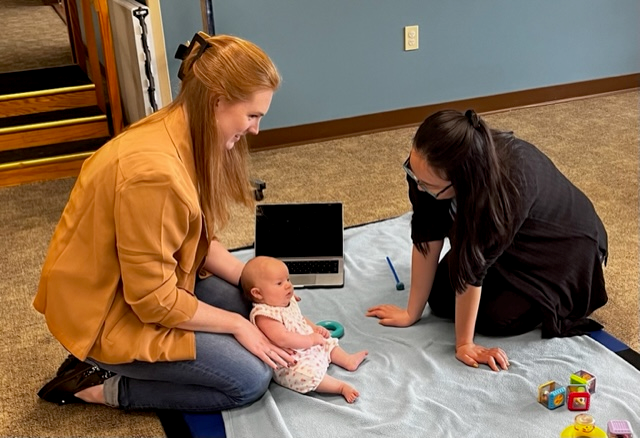
One of the highlights of the busy summer schedule in the Occupational Therapy program is when the babies come by for their annual visit.
By Kelly Osowski
As the OT Adult Clinic Coordinator and Professor in the OT program here at CUW, it has been my honor to coordinate the adult clients in the Community Clinic as well as coordinate “Baby Day” in Occupations Across the Lifespan class. This course is offered to our Post-baccalaureate, Accelerated, and Bridge OT students during their time here at CUW.

In the course Occupations Across the Lifespan, students learn the development of the human lifespan beginning at conception and ending at death through an occupational lens. This course covers the physical, cognitive, and emotional changes that occur across the eight major stages of development: prenatal, infancy, early childhood, mid-late childhood, adolescence, early adulthood, middle adulthood, and late adulthood.
Living dolls
“Baby Day” is when we coordinate babies ages birth to 5 years old from the community with students in the course Occupations Across the Lifespan to test infant reflexes. “Baby Day” is an unforgettable lab experience for OT students. As an occupational therapy practitioner for over 10 years, I still remember “Baby Day” in my graduate program. The hands-on learning experience with babies in order to learn development, reflexes, and how to interact with the baby and parent/caregiver is foundational as an occupational therapy student. The caregivers/parents appreciate the “play time” while students appreciate the low stakes opportunity to test out infant reflexes.
Students learn reflexes such as the palmer grasp which onset is at birth and integrates (disappears) at 3 – 4 months old. The Palmer Grasp is elicited when pressure is placed on the palm of the hand, the response then is the flexing of the fingers. The palmer grasp reflex is a precursor to voluntary grasp and fine motor tasks such as writing. OT students also learn about the Asymmetrical Tonic Neck Reflex (ATNR) which onset is birth and integrates (disappears) at 4-6 months. The ATNR occurs when a child actively turns their head or the student passively turns the child’s head to the right or left. The response is the child’s arm extends on the face side and the back arm flexes. The ATNR purpose is for hand-eye coordination and a precursor for rolling. These are just two of the many reflexes our OT students have the opportunity to elicit and observe in the “Baby Day” lab experience.

“Baby Day” is offered to students and the community fall, spring, and summer semesters and we invite babies from our OT alumni, CUW faculty/staff, and local families to join in the learning experience. “Baby Day” takes place in our new Interprofessional Community Clinic here on the CUW campus.
Want in?
Wherever you’re at in your journey into occupational therapy, Concordia University has options for you at the undergraduate, master’s, and doctoral levels. As a Christ-centered university, our program will help you advance in your calling, by learning from experienced therapists in a hands-on environment and developing a foundation in ethical leadership.

Kelly Osowski is the Occupational Therapy Adult Clinic Coordinator and Professor in the OT program at Concordia University Wisconsin,